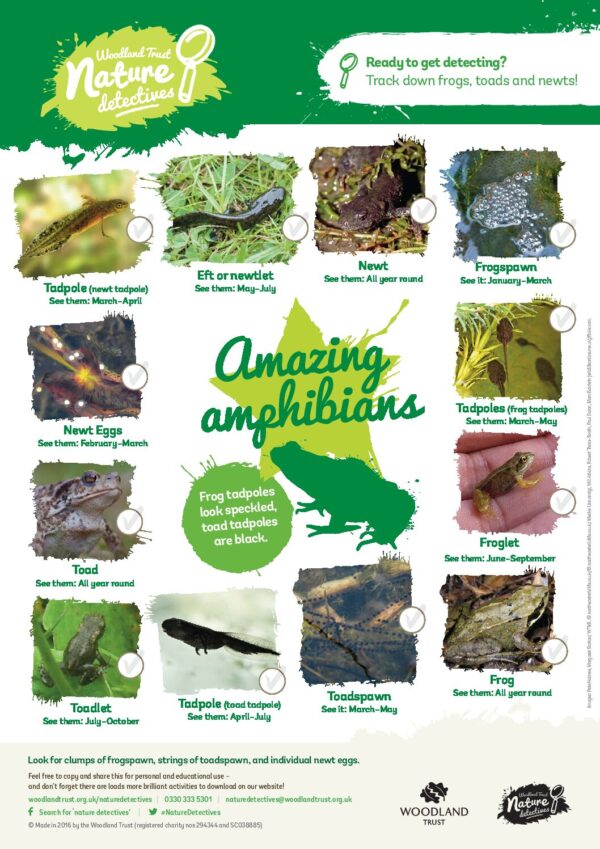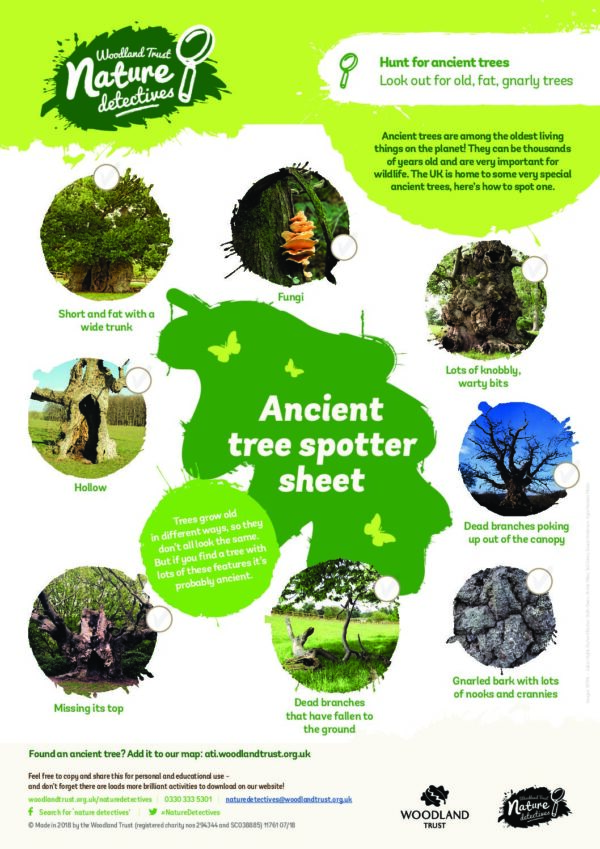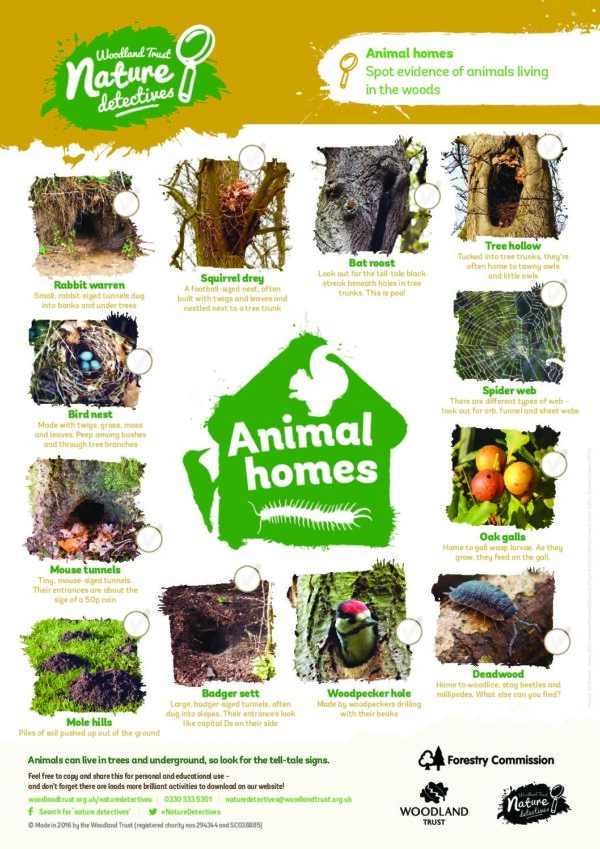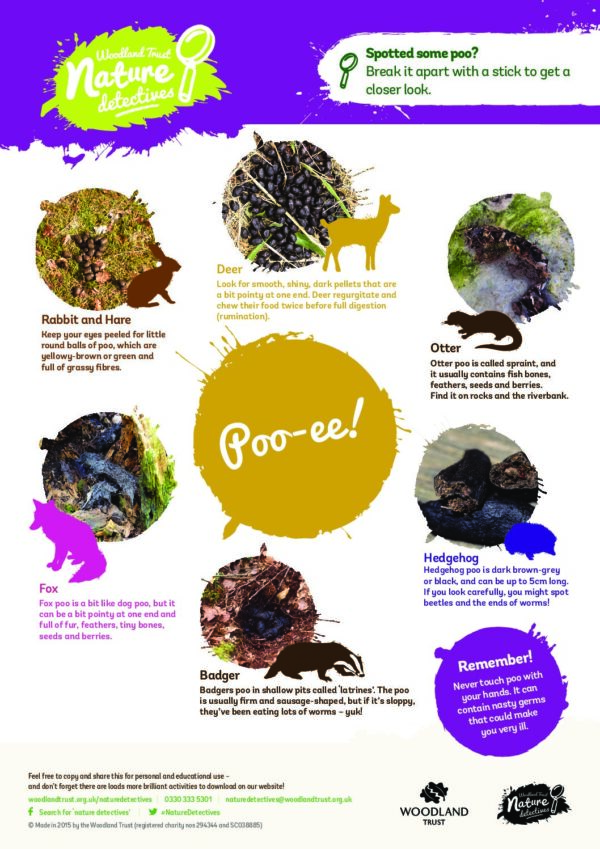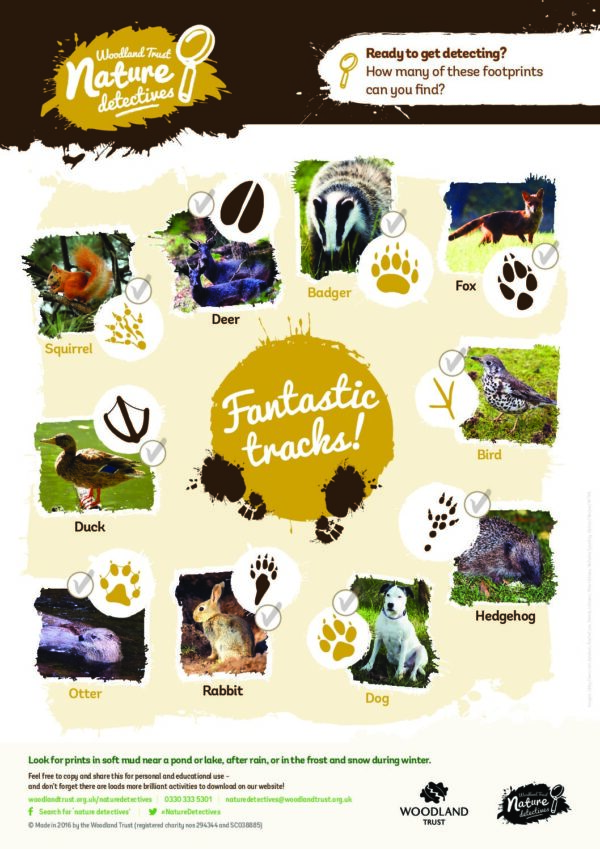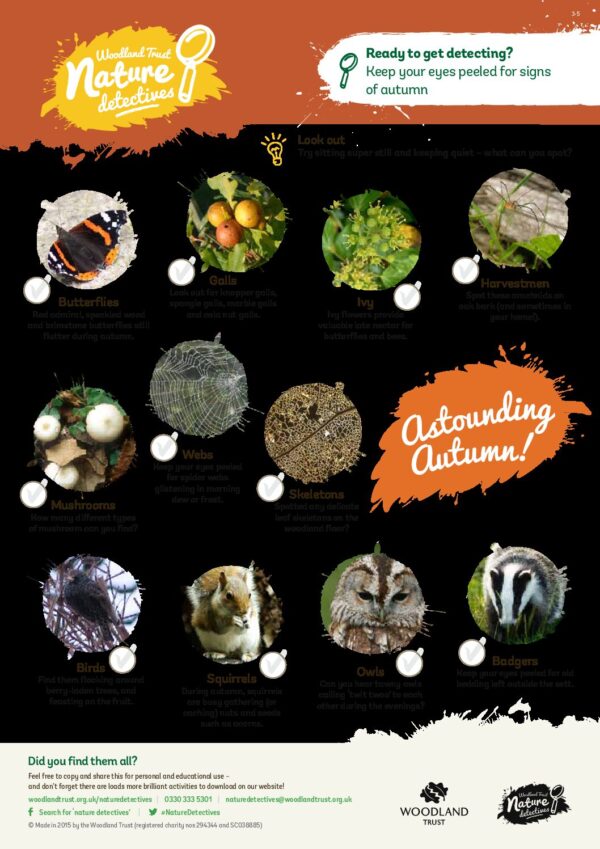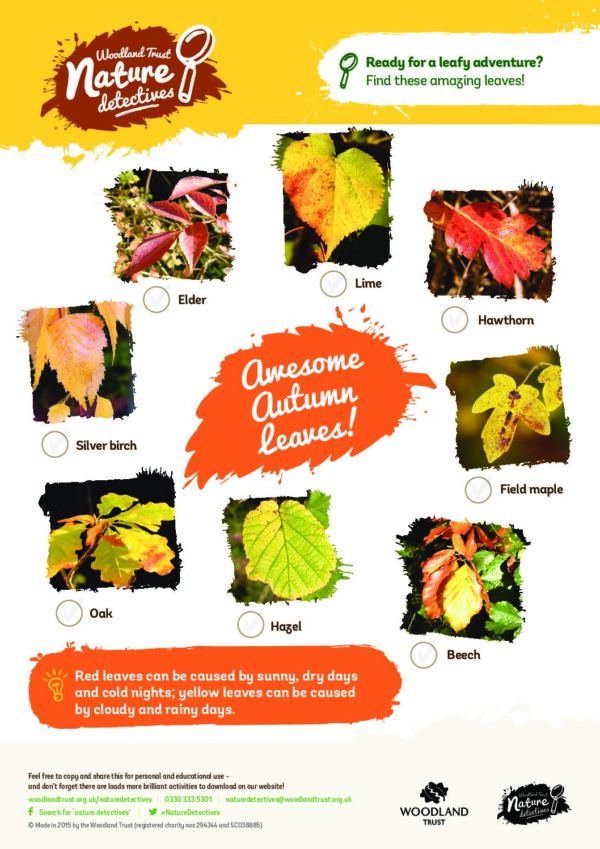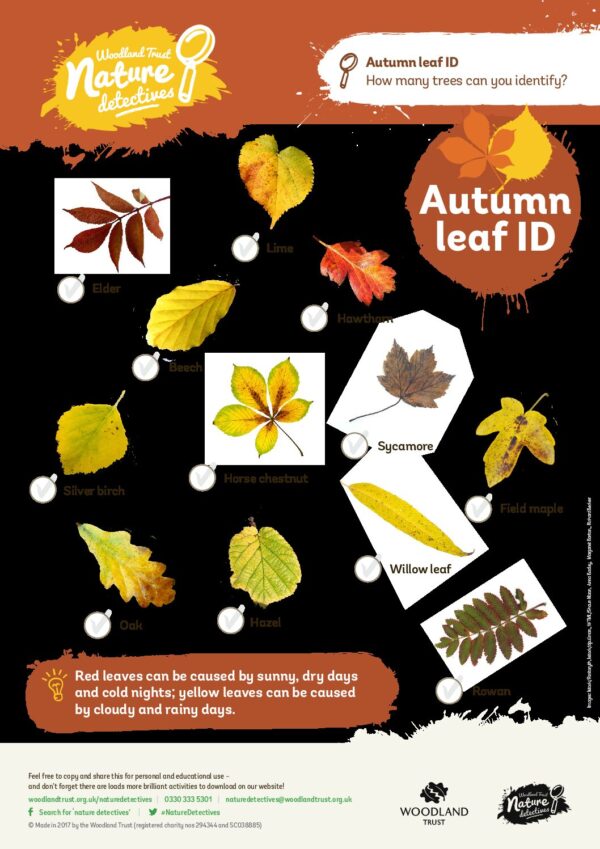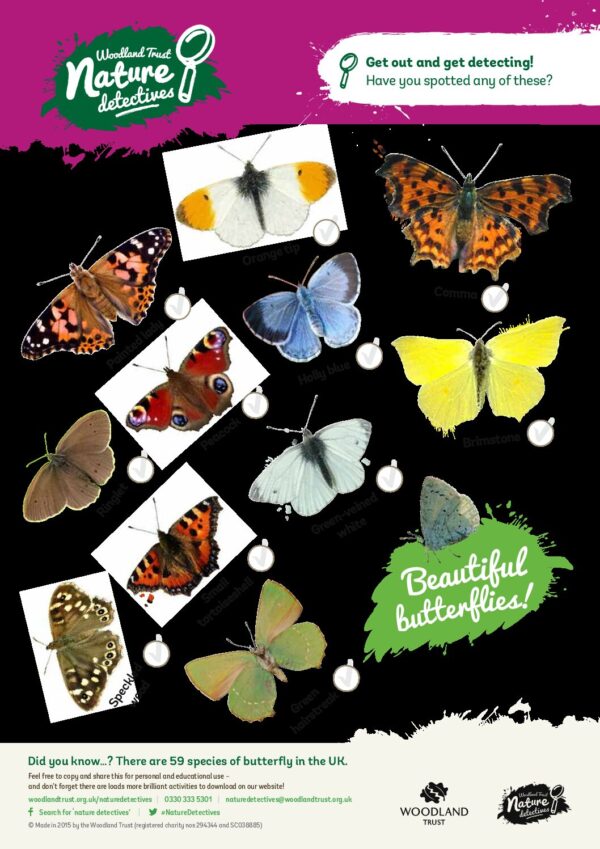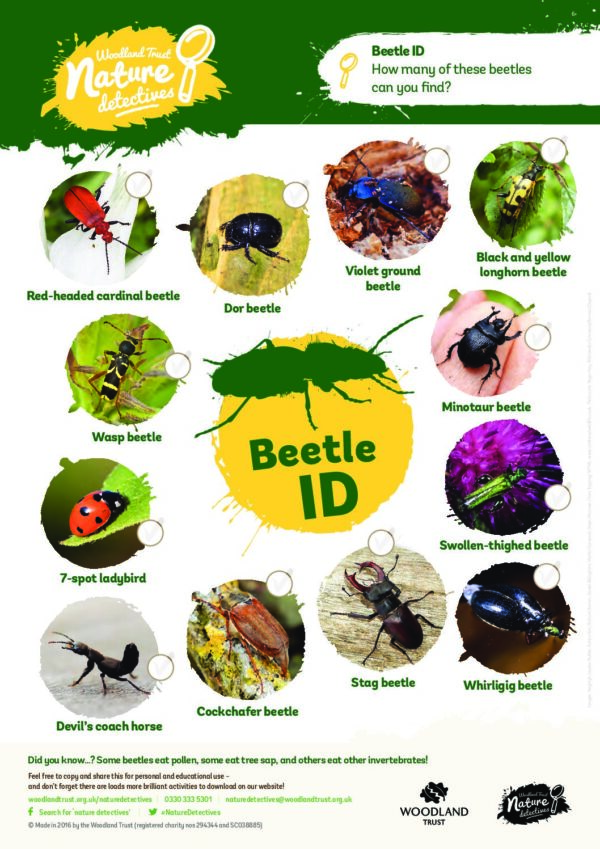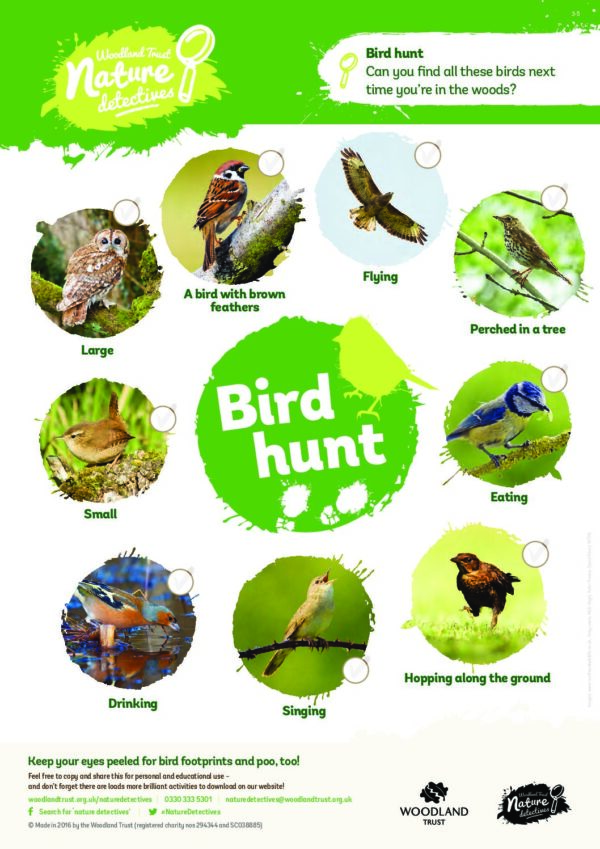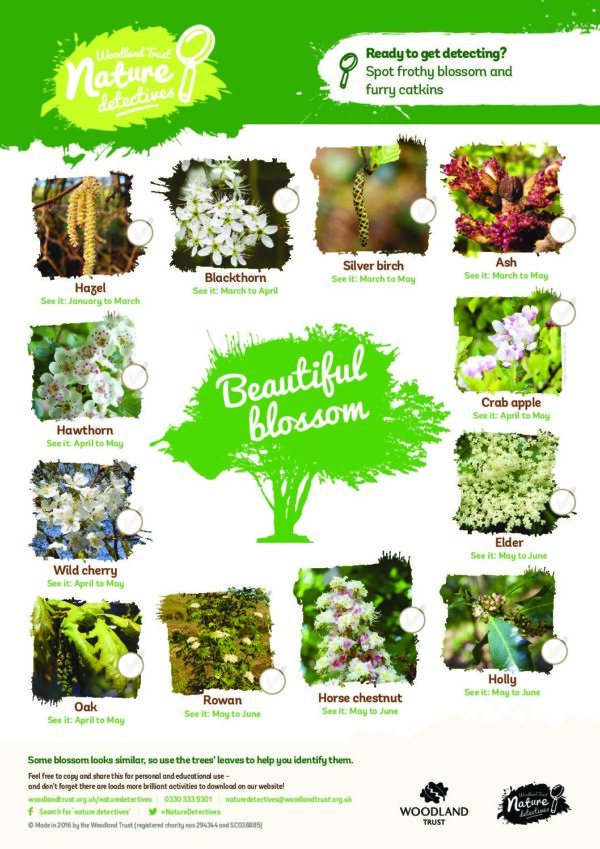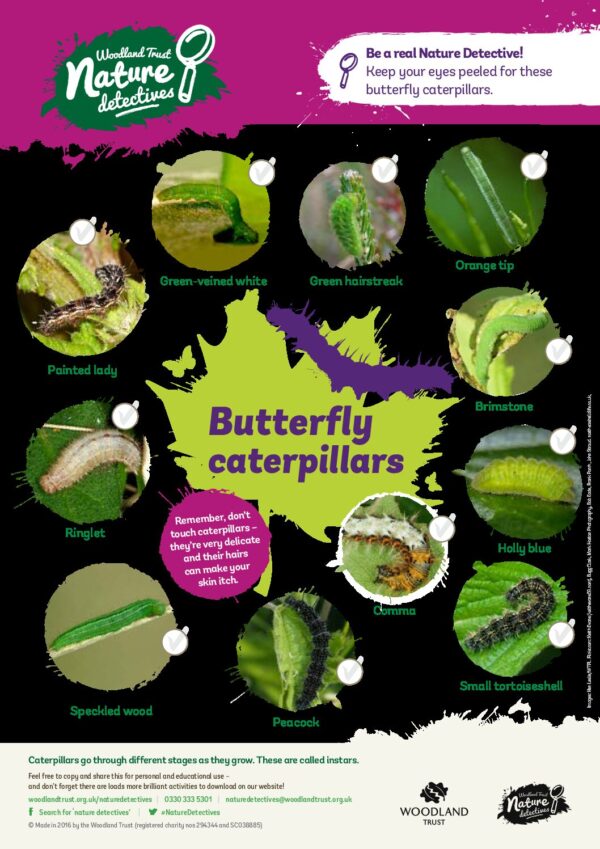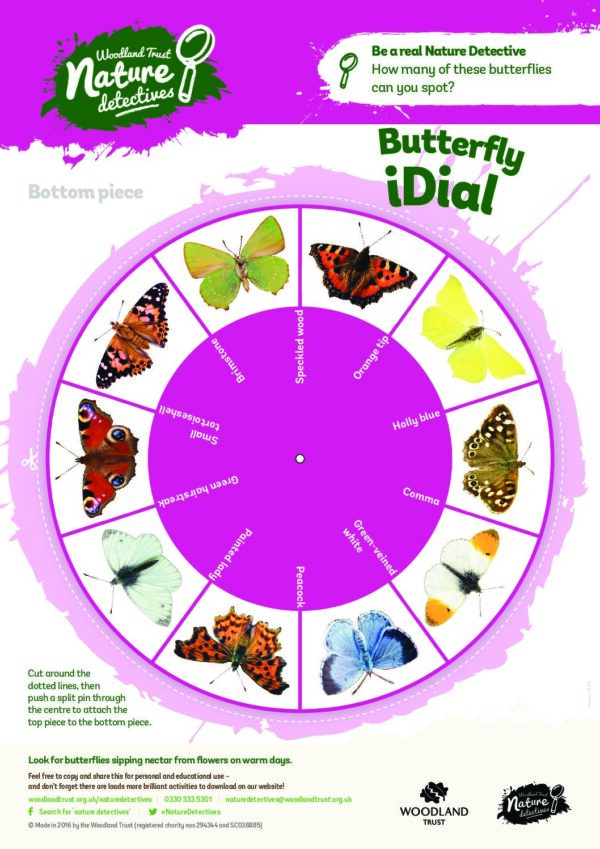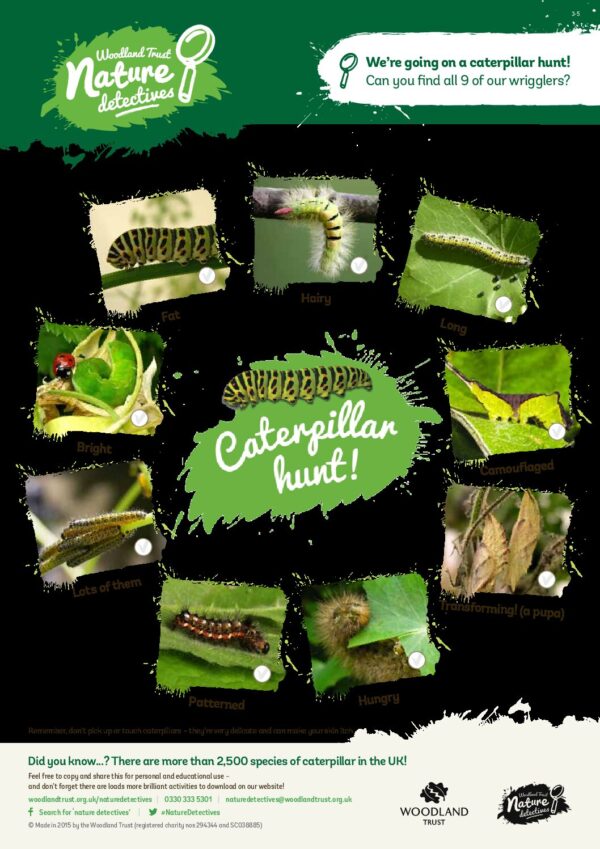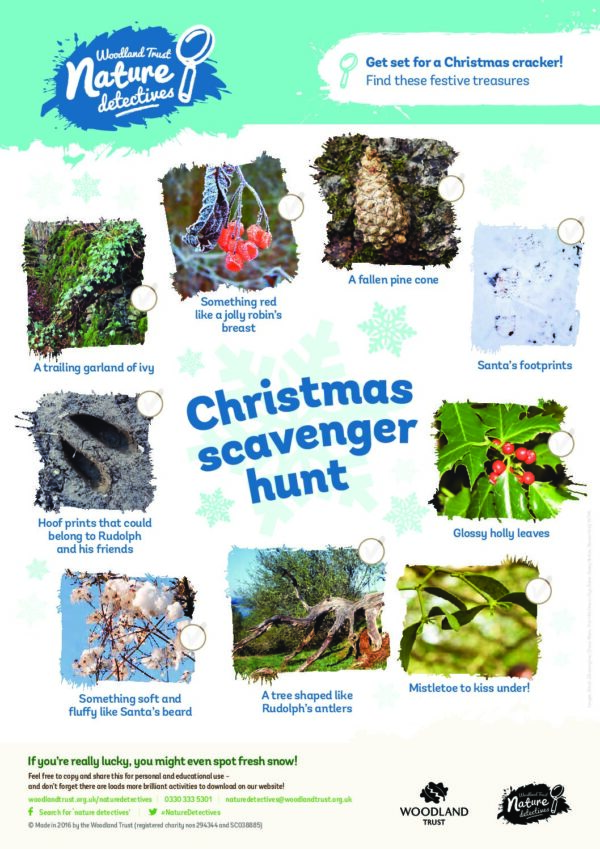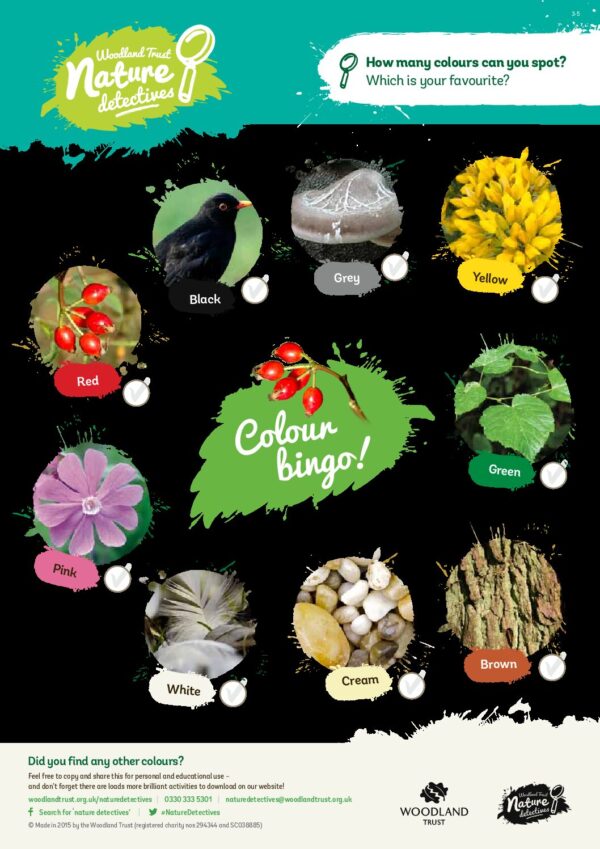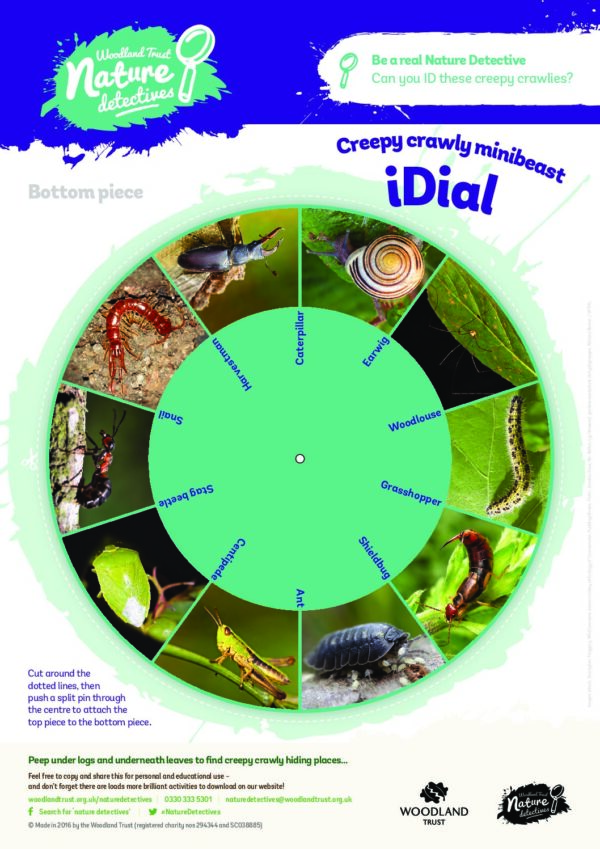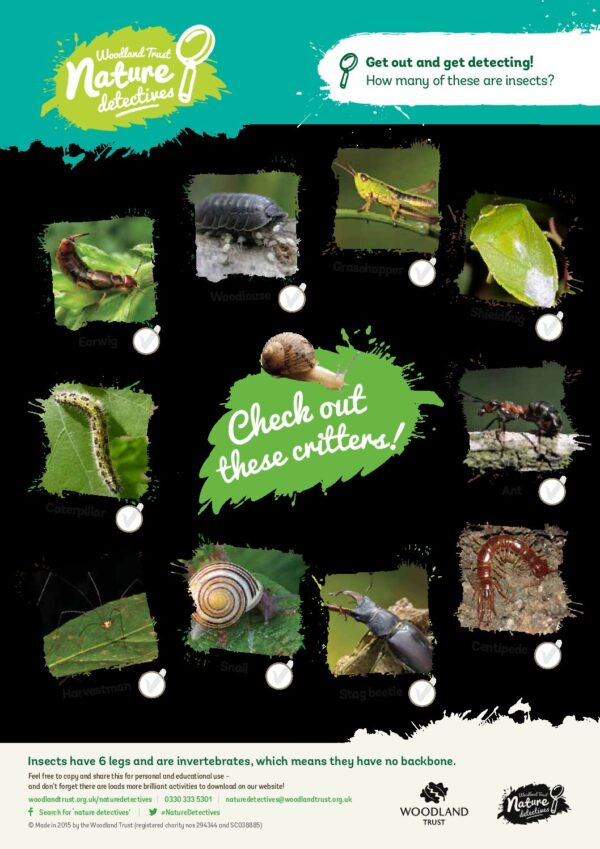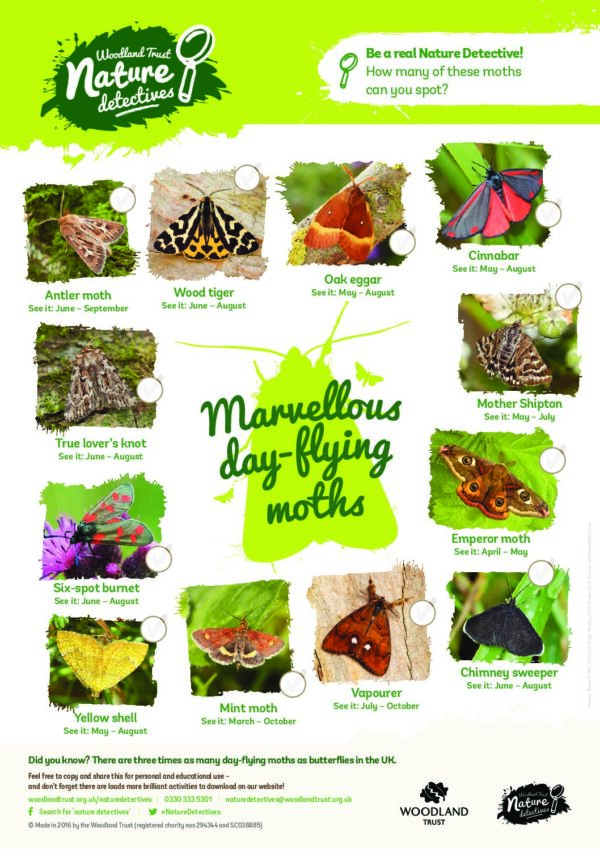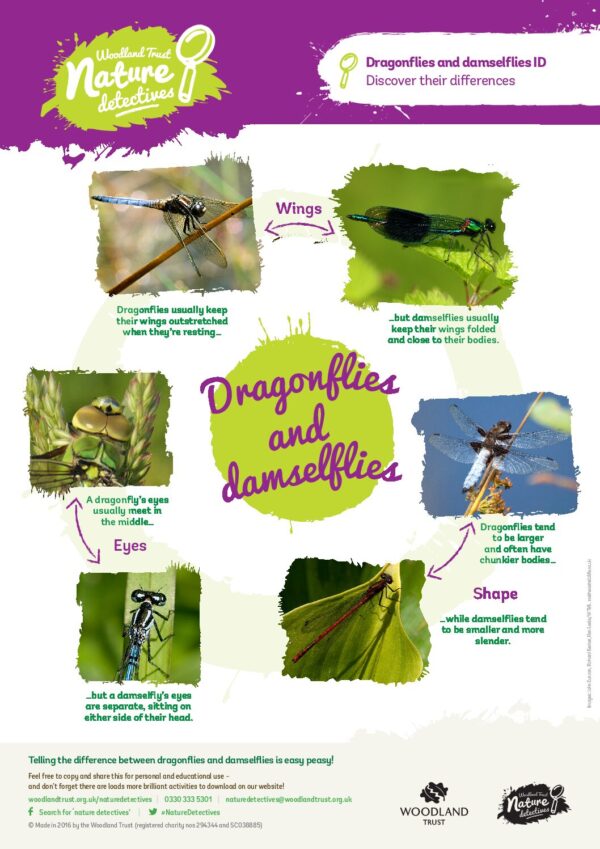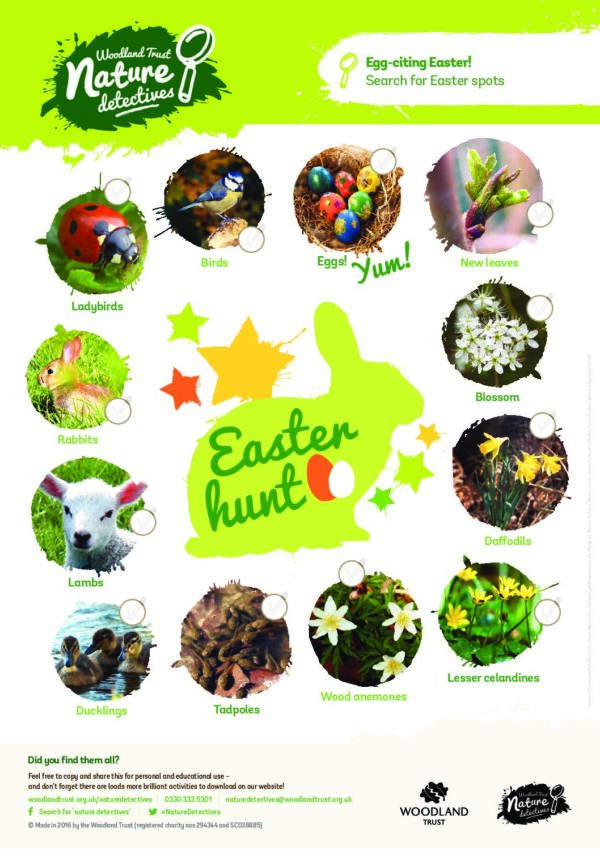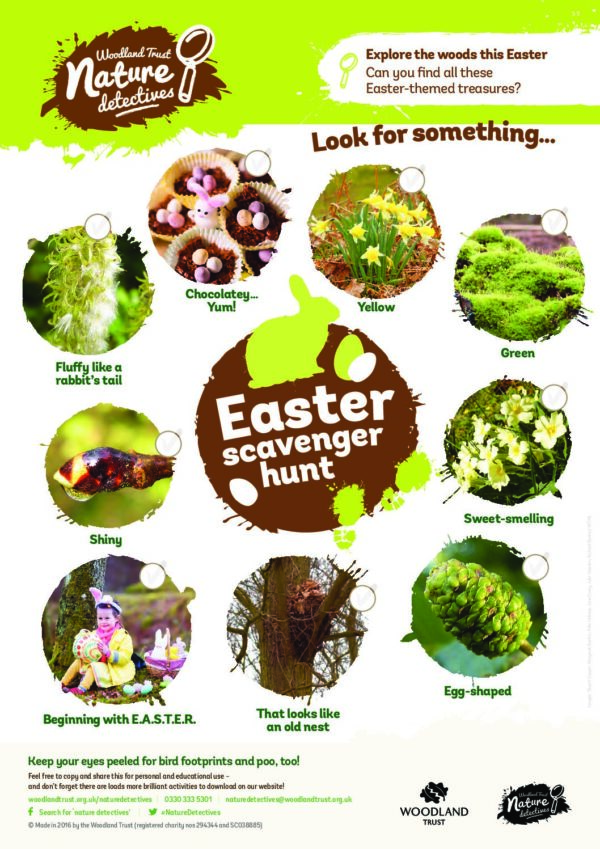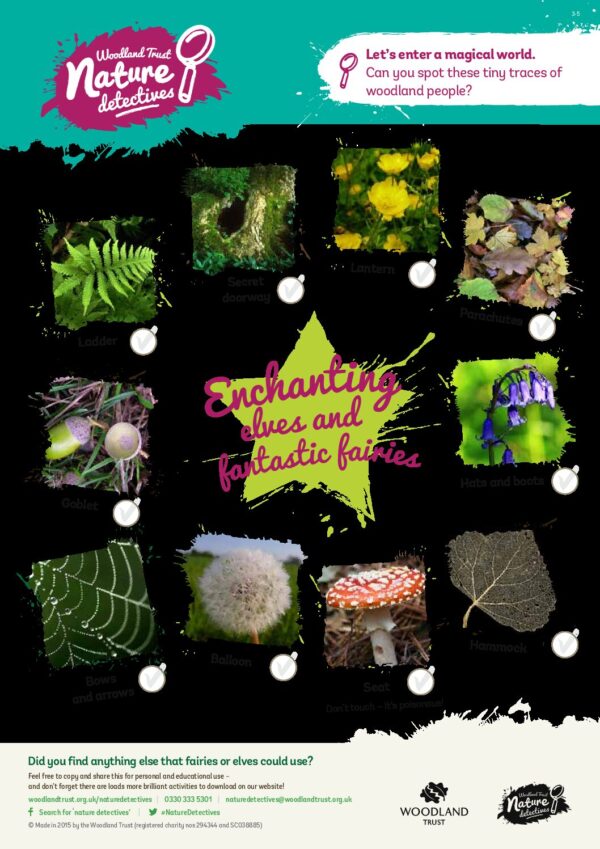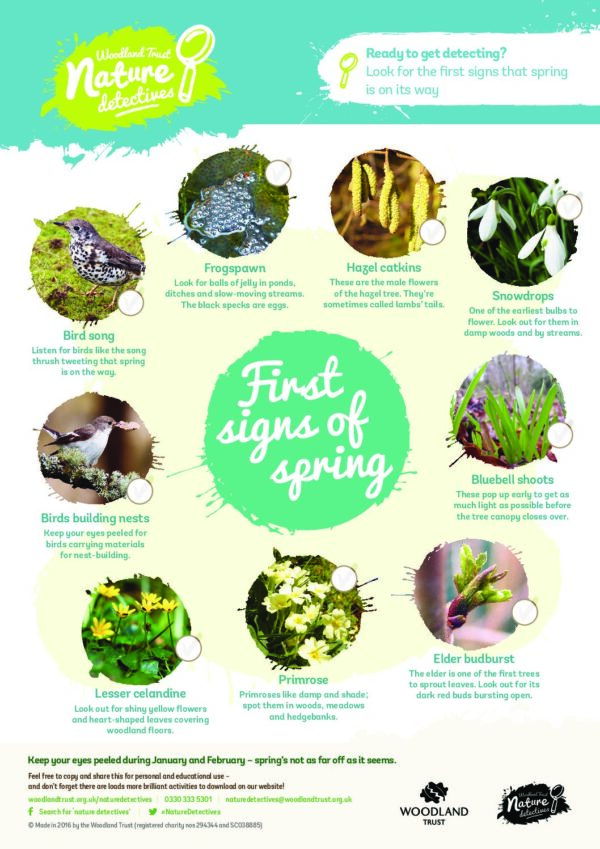spotter sheet
Identify frogs, toads and newts. Learn about life cycles with our handy guide! Use it to spot the different stages of amphibian life: Look in ponds and slow-moving streams Spot eggs in clumps, strings and carefully wrapped around water plants Tadpoles come in different shapes, sizes and colours can you identify them? Eggs, tadpoles and young amphibians appear at different times, so keep your eyes peeled throughout spring and summer!
Learn how to identify the UK’s oldest trees. Look for trees that are: Short and fat, with wide trunks Hollow Covered in knobbly, warty bits Missing their crown (top) Rough and craggy, with lots of nooks and crannies in the bark Home to heaps of fungi, mosses and lichens Trees grow old in different ways, so they don’t all look like this. But if you find a tree with lots of these features there’s a good chance it’s ancient. Did you know? Ancient trees are among the oldest living things on the planet! They can be thousands of years old and are very important for wildlife.
Can you find all these animal homes? Mammals, birds and minibeasts live in all sorts of different places. Keep your eyes peeled next time you’re in the woods. What will you find? Some creatures live underground and some live in trees, so look all around you Can you find evidence like poo and fur? An animal might be living nearby Look out for holes in tree trunks, logs or in the ground – they could be doorways to animal homes! Top tip: tread carefully and quietly on your investigation, so you don’t scare any wildlife.
Get ready to track down some poo and identify the animal it came from! If you’ve ever wondered ‘what does hedgehog poo look like?’ or ‘is that fox scat?’ then this is the ID sheet for you! Learn how to track deer, badgers, rabbits, hares, otters, foxes and hedgehogs by their dro_ppings. Some poo will be hard, some will be sloppy and smelly yuk! Look for poo in the woods and in your garden Can you tell what the animal has been eating? Remember never touch the poo you find as it contains nasty germs. If you want to take a closer look, break it apart with a stick.
Get tracking and ID these animal prints. Be a real Nature Detective and head out on an animal tracking adventure. What will you identify? Look in soft ground around water or after rain Keep your eyes peeled during early mornings and evenings Tracks come in lots of different shapes and sizes, so look closely to spot the differences Can you find all the creatures on our sheet? Can you find any others?
Get detecting and see how many autumn signs you can find. Make sure you’re paying attention while you’re out and about, Nature Detectives. Look in the trees and on the ground Use all your senses what can you hear, see, touch, smell? Some signs might be super small, so keep your eyes peeled How many signs of autumn have you spotted?
Go hunting in the woods for autumn leaves. When you go down to the woods today, keep your eyes peeled for these autumn leaves. Look for leaves in trees and on the woodland floor How many red leaves and how many yellow leaves can you spot? Collect your favourite leaves and use them to make a picture when you get home How many trees and leaves did you ID, Nature Detectives?
How many different autumn leaves can you find? Take our handy ID sheet with you when you’re exploring the woods this autumn. Look for leaves on the trees and on the ground How many different colours can you find? Find out why leaves change colour with our fantastic factsheet
Use this spotter sheet to identify butterflies fluttering in the sunshine. Look out for these insects sipping nectar from flowers and basking in the sunshine. Look for butterfly eggs on the underside of leaves Butterfly caterpillars come in all colours, shapes and sizes, but please don’t Use this spotter sheet to identify butterflies fluttering in the sunshine. Look out for these insects sipping nectar from flowers and basking in the sunshine. Look for butterfly eggs on the underside of leaves Butterfly caterpillars come in all colours, shapes and sizes, but please don’t touch them The transformation stage that takes place when caterpillars become butterflies is called pupation Butterflies come in lots of bright colours. Spot them flitting between flowers throughout the spring, summer and autumn.
Find and identify these beetles when you’re out and about. Look out for beetles scurrying around and among deadwood, tree stumps, flowers and plants. There are lots of different types of beetle how many can you find? Did you know that ladybirds are beetles? Some beetles eat pollen, some eat tree sap and others eat other invertebrates!
Look out for these birds next time you’re out and about. How many different types of birds can you spot? Some might be on the ground, others might be in the trees, and some might even be flying through the air! Tempt birds to visit your garden by leaving out seeds, mealworms and fruit Some birds are really tiny, so you’ll need to keep your eyes peeled! Do you have a favourite bird?
Keep your eyes peeled for frothy blossom and furry catkins. You’ll find blossom almost everywhere you look during spring! Spot white, pink, cream and even green flowers peeking out from hedgerows and branches. And learn how to identify wild cherry, hawthorn, crab apple and more! Different trees bloom at different times Blossom looks like flowers, catkins are long and thin Some blossom comes out before leaves, some afterwards How many different types can you find?
ID these butterfly caterpillars. Keep your eyes peeled for wriggly caterpillars scoffing leaves. Lots of caterpillars are green perfect camouflage against predators like birds Caterpillars are fussy eaters they’ll only munch on their favourite plants All caterpillars go through stages as they grow. These are called instars Some caterpillars are very tiny, so you’ll need to look carefully.
Make an iDial to identify butterflies you spot on your travels. Keep your eyes peeled while you’re out in your garden or the woods. Spot butterflies basking in the sunshine Which flowers are their favourites? Try following a butterfly as it flutters. Where’s it going? Did you know? Some butterflies hibernate during autumn and winter, emerging again in spring.
Head off on a caterpillar hunt and see how many different types you can find. Look carefully under leaves and on plant stems to spot caterpillars. Caterpillars are the larvae (young) of butterflies and moths They can eat up to 27,000 times their own weight to get enough energy to transform into a butterfly The hairs and markings on caterpillars are designed to warn predators that they don’t taste very nice Make sure you don’t pick up or touch any caterpillars. They can be very delicate, and they can also make your skin itch.
Head to the woods and track down festive signs! Can you get a photo of each item on the list? Look for Santa’s boot prints. Can you find a tree shaped like Rudolph’s antlers? What’s red like a jolly robin’s breast? What other Christmassy signs can you find?
Use this spotter sheet to help you hunt out all the colours in nature. Grab your best detecting kit – it’s time to find these colours! How many will you spot? Look for colours in flowers, leaves and berries Can you find them all in the woods? What’s your favourite colour? Once you’ve ticked off all the colours, try looking for others. You could even make a picture using the colours you spot.
Use this handy iDial to identify minibeasts on the ground. Print and make the iDial, then take it with you on a hunt for creepy crawlies! Search under logs, rocks and in the soil Some creatures have no legs, some have six legs, and some have lots of legs! How many different minibeasts can you spot? Did you know? Creepy crawlies are invertebrates: this means they have no backbone!
Are you ready to hunt for these creepy crawly minibeasts? Grab your best detecting kit and head out into the woods or your garden. Search for creepy crawlies among leaf litter and under logs and stones You might spot some minibeasts flying through the air, so keep your eyes peeled Some minibeasts prefer dark, damp hiding places, others prefer sunshine and lush leaves Not all creepy crawlies are insects. Some, like slugs and snails, are gastropods, some, like centipedes, are myriapods, and some, like harvestmen, are arachnids.
How many day-flying moths can you identify? Lots of day-flying moths are brightly coloured and look a bit like butterflies. Use our ID sheet to help you identify them. Moths hold their wings flat when they re resting They usually have thin, comb-like or feathery antennae Moths often have fat, furry bodies Now you can tell the difference between a day-flying moth and a butterfly, get outside and ID them!
Hunt for and ID dragonflies and damselflies. Look out for dragonflies and damselflies, and spot the difference between them. There are three main differences: eyes, shape and wings These bugs zip through the air, so you’ll need to be quick to spot them! You might find one or two resting on leaves Watch for them hunting by water.
Set off on an Easter egg, flowers and wildlife hunt. The Easter holidays are the perfect time to head outside and explore! Use your senses what can you see, hear, smell? Can you find all these exciting Easter signs? How many eggs can you find? Look for frogspawn in ponds, insect eggs on leaves, and chocolate eggs! Did you spot everything on your Easter hunt?
Can you find all these Easter-themed treasures? Head outside and explore this Easter, and keep your eyes peeled! Can you find everything on the list? Did you spot any different Easter-related items? Treat yourself to something chocolatey once you’re finished!
Enter into a magical world and spot tiny traces of elves and fairies. Tread carefully through the woodland and keep your eyes peeled for signs left by woodland people. Look for secret doorways beneath trees and among rocks Remember, leave everything you find behind so that the fairies can use it again Have you spotted anything else the little people could use? Fairies and elves take care of the woods and trees and are very shy, so you might not see them when you visit but that doesn’t mean they re not there. How many signs can you spot?
Look for early flowers, busy birds and frogspawn! It may still be winter, but spring isn’t far away! Keep your eyes peeled in January and February for the very first hints of the new season. Look for tell-tale green shoots popping up from the woodland floor Birds start singing early in the morning can you hear them? Can you find any leaf buds getting ready to burst? What other fresh spring signs can you spot?

